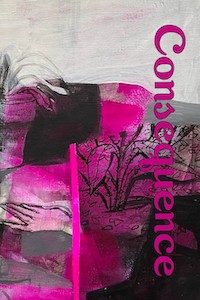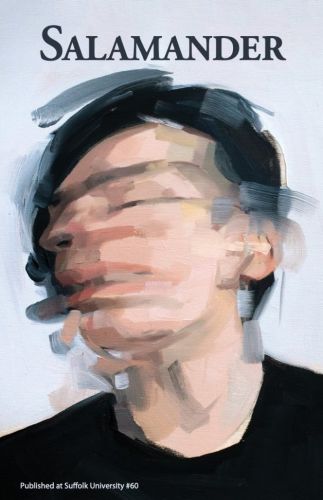Uncle Frank’s Diary
Number Seven

Uncle Frank
Takes a Trip
Uncle Frank’s been to London, to visit the queen.
No, he hasn’t. He hasn’t been anywhere that gives him an excuse for his long failure to provide fresh fodder in this space. One thing and another have conspired to quell his customary compositional regularity, such as it was. In spite of my efforts to help, I have not been able to find, in local drugstores, patent medicines that claim to relieve the cramps and bloating of columnist’s block.
This embarrassing silence may owe to the cold and the dark, to the sodden squish of wet shoes in midwinter, to the nights that begin early and linger late, to one more false promise of a spring that refuses to enter the stage, to that old ennui of snow and ice we Midwesterners know so well.
Or, it may originate in something darker, colder, and longer lasting than mere winter.
A few days ago I took the train to Chicago and back. It was a long day, but worthwhile. I read Steinbeck’s Cannery Row on the coach, looked out the window while listening to the wheels hum on the welded rail (long gone the clickety-clack of the old jointed rail days), and observed my fellow passengers in their curious manifestations of the human condition.
Steinbeck would be 100 years old this year. I don’t know if he ever wrote of Chicago, being mostly a California sort, but I think he would have liked the city. His sympathy with the ordinary man and woman would have served him well on its crowded sidewalks.
The train pulled into the grand old Union Station shortly after noon, giving me a good six hours to do whatever I would before boarding for the return trip. My first act was to dispense with my plan; the day was too unaccountably pleasant (sunny and in the 40s) to spend riding buses to one spot and another. I lit out on the streets, afoot.
Patriotic Barriers
I went first to the Sears Tower, a few blocks north of the train station. The weather looked good for a view from the observation deck on the 103d floor.
Signs of the post 9/11 mindset met me directly. Now protecting the tower one finds innumerable concrete blocks, each a couple of feet high and maybe as long as an NBA center. All these blocks sport a cheerful nationalistic motif. Painted in bright red, white, and blue horizontal stripes, they insist that the passerby notice them and reflect on their meaning.
We know what they mean. They mean that the authorities have taken concrete steps to thwart car bombers, and believe that gussying them up in a guise reminiscent of the American flag will lend that certain something to the atmosphere.
It does, it does. I would have preferred the discreet charm of unadorned concrete, gray, unassuming, content to melt into the background. Red, white, and blue it was, however.
I felt so patriotic as I skirted the perimeter formed by the colorful barriers.
Once upon a time, visitors to the Sears Tower simply walked into the lobby, bought their tickets to the observation deck, and headed on up to see the view. Oh, yes, the program required attendance at a grossly overloud slideshow puff piece on the city narrated by Oprah Winfrey, but that was it.
Now: Take off your coat. Slide it, and any packages or other objects you may be toting, through the x-ray machine. Now please walk through the metal detector. Step back, please. Do you have any keys in your pockets?
And so on.
Oh, it’s good; it’s good to know that Precautions Are Being Taken. I am no more eager than the next gawking tourist to be blown through the glass of the tower’s observation deck by some earnest suicide bomber straight out of Conrad’s The Secret Agent. (If you have not read that book, you’ll find its portrayal of the terrorist bomber unsettling.)
He Went to the Door, But He Couldn’t Get In
On the other hand, that is the word: unsettling. This is not the E-Z access to cultural landmarks that American democracy has afforded us up to now. Other notable buildings in Chicago’s downtown core present a similar dukes-up readiness to take on the bad guys, and leave the good guys wondering whether it might not have been better to visit Galesburg in the springtime, or maybe just stay home.
Sometimes finding an open door is a major challenge. I walked almost the entire circumference of the Prudential Building, another high-rise monument, before I found what was apparently the only exterior door still in service. All the rest were locked. Once inside, I came upon what confronts the visitor to so many major buildings: a phalanx of guards, signs demanding identification, and an evident willingness to take the careless traveler in hand and show him the way, the truth, and the light of America’s New War.
That’s what they’re calling it, anyhow. Apologies to Lou Reed, but this isn’t the beginning of a New Age. It’s the beginning of something else, and something worse.
Open Your Eyes and Look This Way
Something akin to this constricted psychology also reared its head on the train. Hankering for a cup of coffee, I set off to the cafe car, or so I thought. I went the wrong way, and blundered into a coach occupied only by two train personnel. One of them very crisply inquired about my intentions. Smooth-spoken as always (especially before my morning coffee), I attempted to account for my presence in this forbidden zone.
“Uh, I was, uh, is this the way…?”
“You’re going the wrong way,” he said. “The café is at the other end.”
I may have resembled a man desperate to wrest control of the train from the engineer before I revealed my true nature: a man desperate for some caffeine to clear his befogged brain.
In either case, my chances of reaching the train’s controls did not look promising. Consider the fact that a few years ago on the same route, I moseyed freely up to the cab, stood directly behind the engineer, and chatted with him for several minutes as we sped down the track. No one questioned my intentions then (which were nothing but those of a curious traveler and son of a railroad man).
That was back when we lived in an open society. We don’t live there, any more. The doors are closing. The gates are coming down. The locks are clicking shut. Names are being taken, and it won’t be long before retinas are being scanned.
Open your eyes and look straight ahead, please.
A Visit to the Old Library
Is it any surprise that when I visited a library in Chicago, I went to the library that used to be, instead of the library that is? I had intended to stop by the new (or almost new) public library on South State Street. Something led me instead to the old Chicago Public, now a cultural center. I walked up the old stairs and into the lobby, where I found at one side a museum devoted to the history of broadcasting. Incredibly, admission was free, and no one searched me or x-rayed my belongings.
After wandering among the old radios and other exhibits, I went back out to the central part of the former public library and climbed the stairs to what must have been the main reading room. Such attention to detail graces this old building, erected in the 1890s: The ornate ceilings, the painstaking decorative flourishes (are those semiprecious stones embedded in the walls? They certainly look like it, and they’re everywhere. The time that went into cementing them in place would be unimaginable today.)
Coming back down the steps from the reading room, I thought of the countless thousands—the millions—of readers whose feet had pressed upon these stairs, whose hands had touched this marble rail over the building’s life as a library. How many of these readers were immigrants, come to America to make new lives for themselves in this land of hope and—for all its flaws and obstacles—openness of a kind known nowhere else?
Not a Faceless Crowd
When I walk through the streets of a big city, I like to study the faces and listen to the voices of the people around me. It isn’t polite to stare, of course, but you will find, if you try it, that looking at faces on a busy sidewalk is really very easy. Most of the people going by are so caught up in their own business that they do not notice the one observer in the crowd who is looking into their eyes and thinking about them as individuals, and wondering what their faces reveal of their lives.
So many faces, such variety, young and fresh, old and weathered, black, white, brown, yellow… some smiling, some laughing, others concerned, preoccupied, or otherwise engaged in their inner lives. I love to watch them.
And listen to them. Within the space of a few blocks, I heard languages that I recognized, and others whose identity I could only guess. Spanish, Chinese, Russian… to embrace such a cast of characters going peacefully about their business: Only a great city could do that.
And only a great nation can find the courage to remain an open society in this troubled world. Uncle Frank is not sure that the United States will be able to do that. Given a choice, he would probably not mind attending the opening of the old Chicago Public Library, and going on from there. Maybe it would come out another way the second time through.
Here, There and Everywhere in Libraryland
Speaking of openness, it would be hard to find a librarian anywhere who has worked harder or more productively to make library collections more easily accessible to the average citizen than Sanford Berman. Berman, longtime head of cataloging with Minnesota’s Hennepin County Library system, devoted his career to making the library catalog an aid, rather than an obstacle, to people trying to find materials on topics of their concern. For decades, Berman battled to bring catalog language—particularly subject headings—into harmony with the way most library users think when they go hunting for something.
Berman finally ran terminally afoul of his administrative superiors back in 1999. Details of the unseemly circumstances of the cataloger extraordinaire’s ouster (all right, “retirement”) from the HCL are available in a nice archived article in the Minneapolis City Pages.
According to Rory Litwin in an item in Library Juice for March 7, HCL plans to scrap the original subject headings that Berman and crew created over some 25 years, and to replace them with something close to straight (i.e., frequently non-intuitive, obscure, user-hostile) Library of Congress subject headings.
Librarians who continue to argue for clarity and accessibility in their libraries’ catalogs will always owe a debt to Berman, regardless of what goes on in Hennepin County. Uncle Frank hopes that librarians in general do not succumb to the retentive psychology that encircles national monuments with red, white, and blue barriers by being afraid to open their catalogs to transparent language.
Bygone visitors of the old Chicago Public would have welcomed Berman’s hand in their efforts to penetrate the library’s riches. Let us trust that the retro move apparently afoot in Minnesota is no more than a temporary setback, and not something darker, colder, and longer lasting.
Illustration by: K. McGinnis




